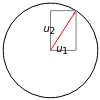Directional Derivatives and the Gradient
Directional Derivatives and the Gradient
This Demonstration visually explains the theorem stating that the directional derivative f(,) of the function at the point , ) in the direction of the unit vector is equal to the dot product of the gradient of with . If we denote the partial derivatives of at this point by and and the components of the unit vector by and , we can state the theorem as follows:
D
u
x
0
y
0
f
(
x
0
y
0
u
∇f(,)·u
x
0
y
0
f
u
f
f
x
f
y
u
u
1
u
2
D
u
x
0
y
0
f
x
u
1
f
y
u
2
In this Demonstration there are controls for , the angle that determines the direction vector , and for the values of the partial derivatives and . The partial derivative values determine the tilt of the tangent plane to at the point , ); this is the plane shown in the graphic. When you view the "directional derivative triangle", observe that its horizontal leg has length 1 (since is a unit vector), and so the signed length of its vertical leg repesents the value of the directional derivative f(,). When you view the "partial derivative triangles", this signed vertical distance is decomposed as the sum +. The first summand is represented by the vertical leg of the blue triangle; the second is represented by the vertical leg of the green triangle. The visual representation is most clear when the two summands have the same sign.
θ
u
f
x
f
y
f
(
x
0
y
0
u
D
u
x
0
y
0
f
x
u
1
f
y
u
2
